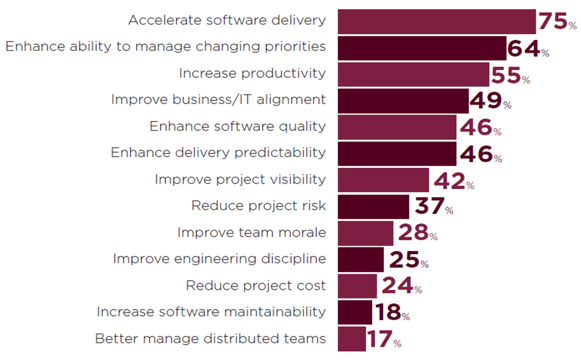I recently came across “Digital Transformation and the CIO: A point of view prepared by IBM and SAP”.
What stood out in this eBook is the need for SAP IT teams to get on the path to SAP agile and develop systems and processes to deliver continuous innovation for the business.
CIOs see agile as key to fostering innovation. Meaning agility is fast becoming a focus for CIOs today.
This focus makes sense, particularly when teams who deliver on CIO objectives understand the benefit of adopting agile methodologies.

Reasons/benefits of adopting agile, Source: “12th Annual State of Agile Report”, VersionOne Inc
The question for SAP IT teams and their CIOs is: what is the path to SAP agile as far as the enterprise core systems of record are concerned?
The path to SAP agile and DevOps
The technical path to SAP agile and DevOps – as opposed to the mindset – is relatively simple.
Even more so if based on the effective use of a change control automation platform.
Given change control automation is in place, here is a common path to SAP agile and DevOps.
- Develop a multi-speed approach to managing SAP change
- Introduce agile development methodologies
- Graduate to a DevOps approach
What does it all mean for SAP IT teams?
Multi-speed approach
There is an unavoidable difference between the rates of change of digital systems of engagement and the SAP systems of record. As a result, a dual speed approach is necessary.
But this doesn’t mean that all SAP change needs to be slow or that governance and control should result in sluggish delivery of SAP changes.
With a multi-track approach SAP IT teams can significantly speed up enterprise change and not compromise governance, control or quality.
The approach is quite simple. Divide the work into types of change by potential impact and run each type down its own delivery and approval track.
Low impact being the faster tracks with fewer approvals and minimal testing, and higher impact the slower tracks.
Agile development methodologies
Whether the work is divided into sprints, stories or releases, methods of delivering smaller pieces of quality-build software, fully tested and ready for deployment are required.
Smaller pieces of functionality will have lower overall impact, require less rigorous testing and can be delivered faster.
This builds on the multi-track release methodology.
As far as possible, work is developed to minimize impact, so it can be run down the faster, low impact tracks.
In turn, unavoidable, high-impact changes can run down the slower, more controlled tracks.
Leaving only the unavoidable, high-impact changes being run down the slower, more controlled tracks.
March towards SAP DevOps
Shifting left things like QA, impact assessment and testing to be in-process allows developers to understand the impact of their changes earlier.
As a result more change can be developed at the lowest impact, increasing the volume of faster track changes.
It requires the use of a range of intelligent ALM tools (SAP native or third party) that automate DevOps activities including code review, impact assessment, and unit and regression testing.
Integrating these tools into the development cycle and then linking them via an automated change control platform, like Rev-Trac Platinum, allows a single unified approach supporting SAP DevOps.
Reduced operational costs, increased production system stability and more time to innovate are just some of the demonstrable benefits.
How to get there
Good governance and control and rapid software application development don’t have to be mutually exclusive.
Rev-Trac Platinum automates both the tasks and processes required for good SAP change management and the controls needed to enforce a multi-track approach, putting you on the path to SAP agile.
Additionally, the software automatically orchestrates the DevOps activities, so they become as ‘in-process’ as other development tasks.
To discuss how to get on the path to SAP agile and innovate faster contact sales@rev-trac.com to speak to one of our SAP change control experts.
